The Blossom Bright
- Project:
- Year:
- The Blossom Bright
- 2016
Embodied Interaction | Aesthetic Interaction | Usability | Interaction Design | Interactive Artefacts | Emotional Responses
In this project we explored how physical movement of people and everyday products, as well as the coupling between them, impact interaction aesthetics with respect to usability and expression.
Project background
Video of different types of motions that we observed
Designing interactive artefacts deals with the experiences that arise in the meeting between interaction design, ubiquitous computing, and critical approaches to design.
Our bodily movements and the perception of movement in our environment are essential to the interaction with the physical world and may contribute to the aesthetic experiences with interactive products.While interacting with digital products in everyday life we are only introduced to the final use of the products. Studying the work of interaction designers enable us to explore the developing stages before product launch. This helps us understand decisions made by interaction designers on how users engage with physical objects through their bodily movements.
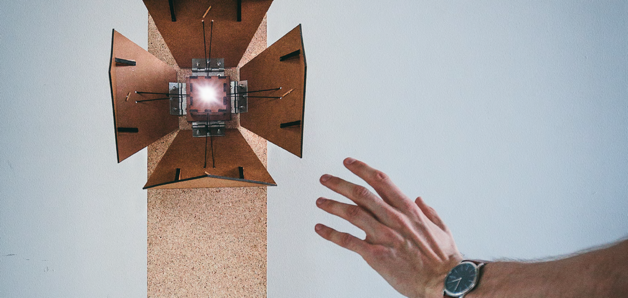
We started the design process by looking deeply into the effect of motions and emotional responses within interaction design. To drive design decisions, we had to make a link between the act of motion and a physical product. At this point there were no doubt that we wanted to develop a product in which a person experiences a particular emotion in relation to the object.
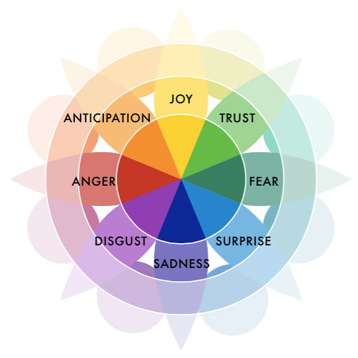
We observed different emotions in movements using the Plutchik Wheel (Plutchik, 1980), which illustrates how emotions relate to each other. Each object was described in terms of its movement. We analysed what makes each object move, how it moves, and finally, which emotions each movement evokes. For instance, a microwave door opens due to human action. At first the door makes a rapid swing as giving a resistance and subsequently slows down as it opens more. According to our interpretation, this act corresponds to the feeling of surprise and shock as a result of an unusual or unexpected act. Hence, we were able to see the object not only as a whole, but explore the reasons behind functionality of the object.
Connection between movements and emotions in a “lamp“ as an artefact
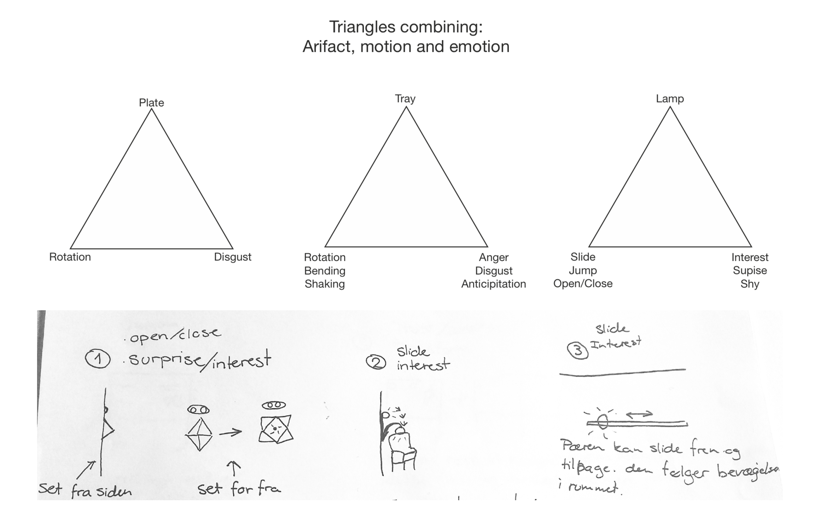
Interaction development & idea development
Further in our process we created three triangles, each of them containing one artefact (tray, door and lamp), as well as movements and emotions connected to the artefact.
We made three storyboards and used a body storming technique to act them out in real life as can be seen on the video. By combining the three elements of interaction design: physical form, temporal form and interaction gestalt (Vallgårda, 2013), we are able to create a successful design that communicates the intended message those who interact with the artefact.
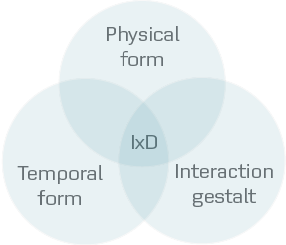
In moves, temporal form is a composition of actions, the physical form is the three-dimensional shape of the object, and the interaction gestalt is the performance of movements that a human actor does in relation to the object (ibid.).
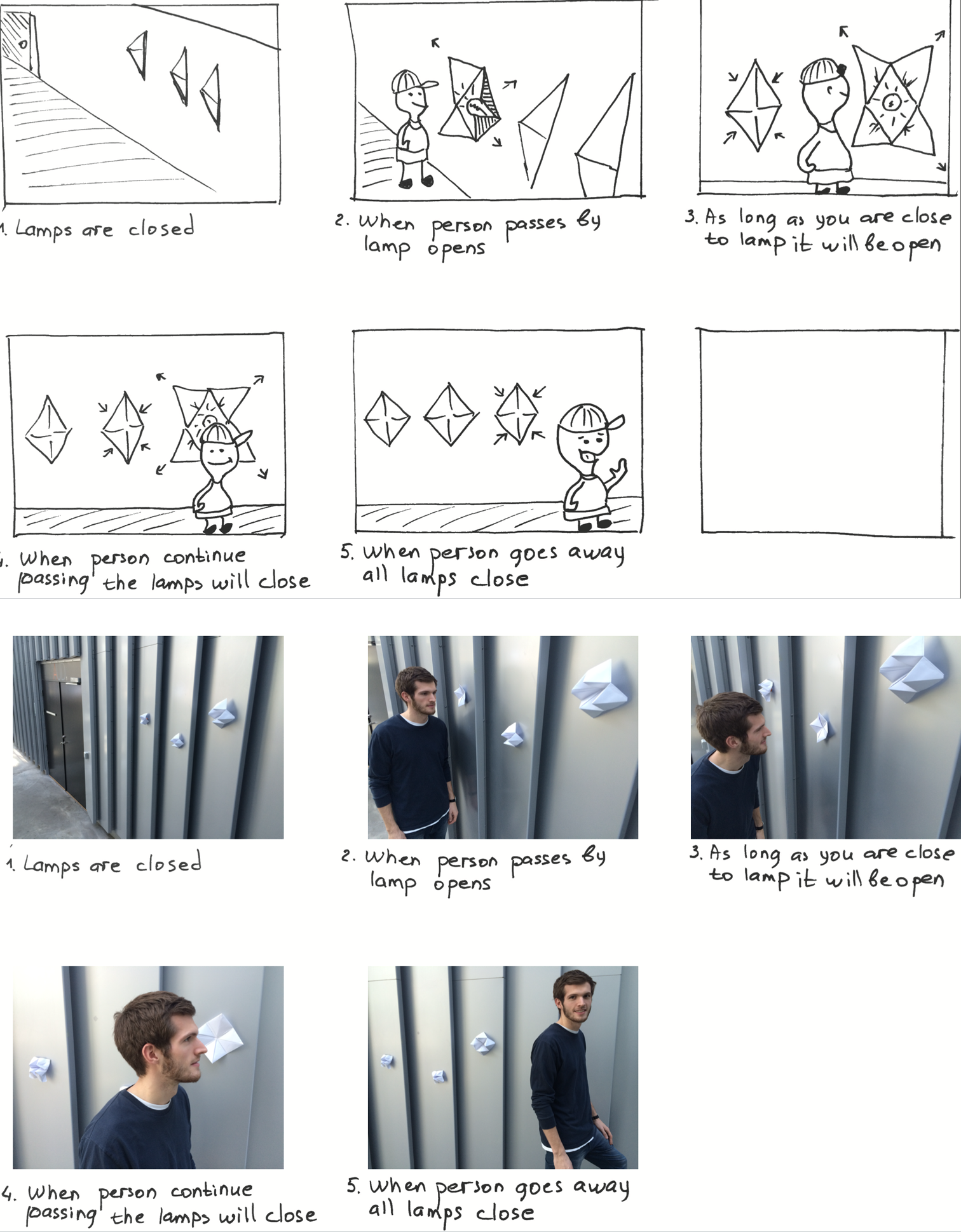
Idea generation
The idea of a cootie catcher consists of very simple movements; opening and closing. The storyboard we made for the cootie catcher shows the interaction with the artefact. The storyboard, both on paper and in pictures, shows functions as scenarios on how we expected the cooties catcher to react when it is interacting with humans.

Prototype development
Prototypes are widely recognized to be a core means of exploring and expressing designs for interactive computer artefacts (Houde et. al, 1997:1). To develop the concept of our artefact we built different prototypes, both physical and electronic, in order to represent different stages of our design and to explore new possible options.
After exploring different options on defining the core function of the artefact we developed a concept of encouraging the user to move away from the artefact itself. Essentially, the function depends on the distance towards the artefact. E.g. it invites you to come closer if you are far away from the artefact or it will encourage you to move away if you are close to the artefact. Thus the artefact aims to move people away from itself, rewarding a person with the full view of the blooming artefact, and the revealing of the light in the center, which is the core function of the artefact.

The second dimension “Look and feel” denotes questions about the concrete sensory experience of using an artefact - what the user looks at, feels and hears while using it (ibid.). This comes to light in prototyping with the physical form. Here, we were introduced to laser cutting as a tool to cut materials in a specific pattern leaving an edge with a high quality surface. By taking the physical form of a cootie catcher and separating each of the four corner tabs, we came up with an idea of making each tab into four leaves. The natural shape of a flower inspired us to focus on the organic motion of flourishing leaves.
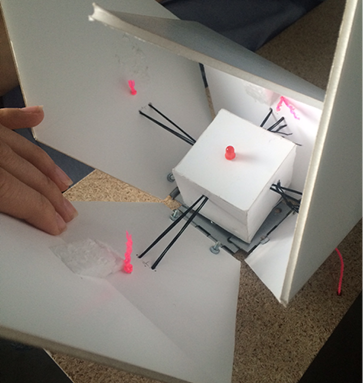
Thus, the reason of bending the leaves of the artefact is related to aesthetic reflections on how the artefact should communicate the core functions to it’s audience. The third dimension “Implementation” is about electronic prototyping and refers to questions about the techniques and components through which an artefact performs its function - the “nuts and bolts” of how it actually works.

Design vision and constructed prototype
We took our point of departure in the physical form of the cootie catcher, and the accompanying question: How do we make a diminutive artefact communicate shyness and spark interest? We set out to create an object that would not only capture the imagination of the user, but also create a sense of coherence between technology and nature.
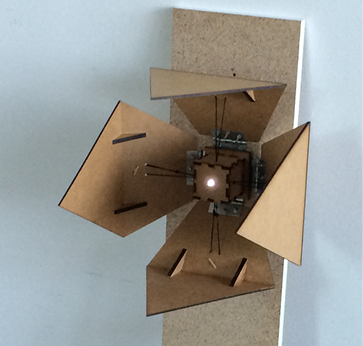
Drawing inspiration from the shape and movement of a blossoming flower, the artefact looks as if it’s almost growing out of the wall, approximately eye level with the user. The idea is that the artefact sits on the wall in large numbers and in many different sizes, imitating flowers on a field. It is built to actively encourage real-life interaction between people. Like flowers in spring, the shape and movement of the artefact takes its point of departure in nature itself and the blooming of a flower; a universal concept spanning cultures and language barriers.
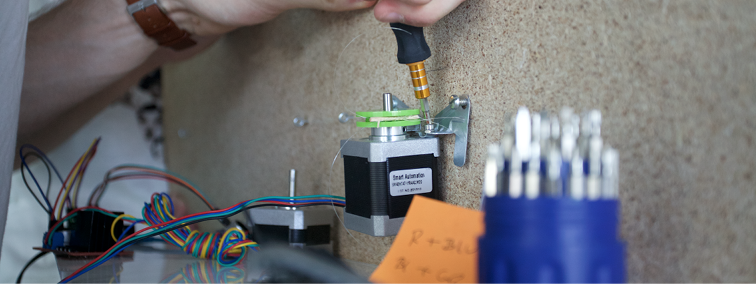
Reminiscent of leaves, each individual Blossom Bright consists of four concave leaves that open and close, depending on the distance and movement of the individual. These are the two temporal aspects that the artefact will respond to. Reversing the process of a blooming flower, the wings of the artefact close as you move towards it - and open as you distance yourself from it, revealing a soothing light in the center of the artefact. In this way, the artefact aims not to draw much attention, but rather encourage the individual to move away from the walls and further into the room, rewarding you for spending time on what really matters - other people.
As a whole, the idea is that the artefact creates an element of surprise in its blooming motion, draws people away from the walls and into the room, sparks conversation and lights up the space.
Our bodily movements and the perception of movement in our environment is essential to the interaction with the physical world, and contributes to the aesthetic experiences with interactive products.
